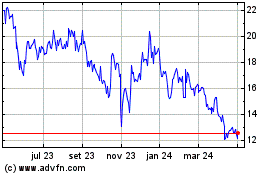US index futures indicate a higher open in pre-market trading
this Wednesday, as investors focus on the Federal Reserve’s
monetary policy decision and Jerome Powell’s press conference.
Earnings highlights include Boeing, Mastercard, Kraft Heinz, Meta
Platforms, Arm Holdings, and Qualcomm.
At 5:24 AM, Dow Jones futures (DOWI:DJI) rose 169 points, or
0.41%. S&P 500 futures gained 0.91%, and Nasdaq-100 futures
advanced 1.44%. The 10-year Treasury yield was at 4.144%.
In the commodities market, oil futures rose following the
assassination of Hamas leader Ismail Haniyeh, increasing tensions
in the Middle East. West Texas Intermediate crude for September
rose 2.73% to $76.77 per barrel. Brent crude for September rose
2.57% to near $80.65 per barrel. Despite this increase, prices are
still pressured by concerns over weak demand from China and
expectations of production cuts by OPEC+.
On Wednesday’s US economic agenda, the ADP will release private
sector job creation data for July at 8:15 AM. At 8:30 AM, the
Chicago Fed will release the July national activity index. The
Department of Energy (DoE) will present the oil inventory position
at 10:30 AM. At 2:00 PM, the Federal Reserve will announce its
monetary policy decision, followed by a press conference with Fed
Chairman Jerome Powell at 2:30 PM.
European markets are higher, driven by the technology sector,
with investors focused on corporate earnings and digesting eurozone
inflation data. Eurozone inflation rose to 2.6% in July, contrary
to economists’ expectations that it would remain at 2.5%. In June,
inflation was 2.5%, after 2.6% in May. Core inflation, which
excludes volatile prices of energy, food, alcohol, and tobacco,
also rose to 2.9% in July, exceeding the estimate of 2.8%. These
numbers suggest persistent inflationary pressures in the European
economy.
In France, inflation rose 2.6% in July, below the forecast of
2.8%, providing mixed data for the ECB and showing more controlled
inflation than in Germany and the Netherlands. On Tuesday, the
eurozone’s second-quarter GDP grew 0.3%, slightly above
expectations.
Asia-Pacific markets closed higher, with Japan’s Nikkei 225 up
1.49%, reaching 39,101.82 points. Australia’s S&P/ASX 200
advanced 1.75% to 8,092.3 points. South Korea’s Kospi increased
1.19%, closing at 2,770.69 points. Hong Kong’s Hang Seng rose 2.24%
to 17,383.25 points. China’s Shanghai Composite gained 2.06%,
ending at 2,938.75 points.
The Bank of Japan (BOJ) surprised by raising its short-term
interest rate to 0.25% and halving its monthly bond purchases. This
change, signaling a gradual end to monetary stimulus, contrasts
with other economies lowering rates. The yen temporarily rose, and
the BOJ maintained its inflation forecast at 2% until 2026.
Additionally, Japan’s industrial production fell 3.6% in June, less
than the predicted 4.8% decline. Manufacturers expect a 6.5%
production increase in July and 0.7% growth in August, according to
the Ministry of Economy, Trade, and Industry. Retail sales grew
3.7% in June year-on-year, exceeding the market’s expected 3.2%
increase.
In China, the manufacturing PMI fell to 49.4, signaling
contraction for the third consecutive month and remaining below the
50 growth line. The non-manufacturing PMI fell to 50.2, below the
50.3 forecast, highlighting a slowdown in the services and
construction sectors. Additionally, the China Securities Regulatory
Commission replaced Vice Chairman Fang Xinghai with Li Ming, head
of the inspection department. Fang had been in the role since 2015
and is retiring, as reported by the Global Times.
In Australia, second-quarter inflation rose 1% from the previous
quarter, reaching 3.8% annually in June. This figure aligns with
expectations and is a slowdown from May’s 4%. Lower inflation may
allow the Reserve Bank of Australia to consider rate cuts or avoid
increases, as discussed at the last monetary policy meeting.
On Tuesday, the Dow Jones rose 0.50%, closing at 40,743.33
points, while the Nasdaq fell 1.28%, ending at 17,147.41 points,
its lowest level in over a month. The Nasdaq’s decline was driven
by pressure on tech stocks, with Nvidia (NASDAQ:NVDA) falling 7%.
The S&P 500 also retreated, dropping 0.50% to close at 5,436.44
points.
In Wednesday’s quarterly earnings reports,
Boeing (NYSE:BA), Mastercard (NYSE:MA), Kraft
Heinz (NASDAQ:KHC), Altria (NYSE:MO), Norwegian
Cruise
Line (NYSE:NCLH), Wingstop (NASDAQ:WING), Cameco (NYSE:CCJ), Humana (NYSE:HUM), Generac (NYSE:GNRC), Teva
Pharmaceutical (NYSE:TEVA), and more will report
before the market opens.
After the close, numbers from Meta
Platforms (NASDAQ:META), Arm
Holdings (NASDAQ:ARM), Qualcomm (NASDAQ:QCOM), Lam
Research (NASDAQ:LRCX), Carvana (NYSE:CVNA), Western
Digital (NASDAQ:WDC), Riot
Platforms (NASDAQ:RIOT), Paycom
Software (NYSE:PAYC), Albemarle (NYSE:ALB), Agnico
Eagle Mines (NYSE:AEM), and others are awaited.
xxx
xxx
After the close, numbers are expected from Wynn Resorts
Ltd (NASDAQ:WYNN), Supermicro (NASDAQ:SMCI), Rivian
Automotive (NASDAQ:RIVN), Airbnb (NASDAQ:ABNB), Devon
Energy
Corp. (NYSE:DVN), Reddit (NYSE:RDDT), GigaCloud
Technology
Inc (NASDAQ:GCT), Upstart Holdings (NASDAQ:UPST), Amgen (NASDAQ:AMGN), Axon
Enterprise (NASDAQ:AXON), AMSC (NASDAQ:AMSC, Fortinet (NASDAQ:FTNT, Lumen
Technologies (NYSE:LUMN),
Illumina (NASDAQ:ILMN), VF
Corp (NYSE:VFC), Coupang (NYSE:CPNG),
among others.
VF (NYSE:VFC)
Gráfico Histórico do Ativo
De Dez 2024 até Jan 2025

VF (NYSE:VFC)
Gráfico Histórico do Ativo
De Jan 2024 até Jan 2025
